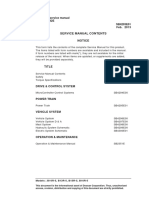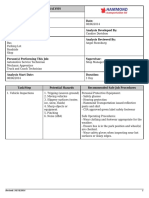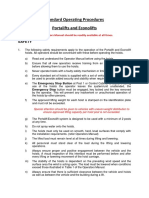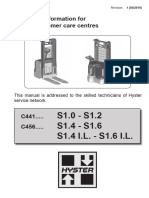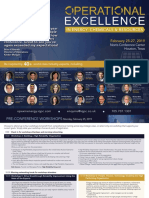Doc Manual Engine Hoist
Uploaded by
queenboitumelo09Doc Manual Engine Hoist
Uploaded by
queenboitumelo09Safe Operating Procedure
Manual Engine Hoist
The instructions recommended within this document apply to normal risk conditions. If the Engine
Hoist is to be operated in a dangerous or hostile environment, the user/client is responsible for
conducting an appropriate risk analysis and applying suitable controls to mitigate those additional
risks.
This instruction should be read in conjunction with the Risk Assessment procedure for the Engine
Hoist.
Safety risks:
• Hydraulic Failure
• Manual Handling
• Crushing
You must wear this personal protective equipment when doing this task:
Foot High Eye
Protection Visibility Protection
Pre-Operational Checks:
Locate and ensure you are familiar with all hoist operations and controls.
Ensure no slip/trip hazards are present in workspace and walkways.
Put the Engine Hoist in a suitable location for safe operation and apply the brakes.
Check that all fittings and connections and safety guards are in fitted and good
condition prior to starting e.g. Pins and bolts.
Check for signs of hydraulic fluid leaks and ensure no cracks or damage on hoist.
Faulty equipment must not be used. Immediately report suspect machinery to Rapid
Hire.
Access and egress is clear.
lighting is appropriate for task.
Ensure exclusion zone is clearly marked.
Safe Operation:
1. Use equipment in applications for which it is intended for.
2. Be aware of “pinch points” and keep fingers and feet away.
3. Check there is sufficient height for ram and boom.
4. Be sure load is secured and cannot move from the vertical line.
5. Use correctly rated SWL slings or chains to secure engine.
6. The approved lifting weight for each crane is stamped on the identification plate and
must not be exceeded.
7. The hoist must only be used on smooth, hard, level surfaces.
8. Lifting arm to clear the engine bay, wheel crane into position at the front of the
vehicle.
9. Close bleed valve on ram and pump handle to set ram to required height for
positioning hook over the engine.
10. Connect hook to engine sling and Ensure load is balanced.
11. Pump ram so engine clears vehicle body and lower engine crane slowly.
12. Be sure equipment will not tip over, roll or slide or fall when not being operated.
13. Leave the machine in a work area that is safe, clean and in a tidy state.
SOP-0010 Version 1.0
Page 1 of 2 Approval Date August 2017
Safe Operating Procedure
Manual Engine Hoist
Storage & Maintenance:
1. Before storage, twist release valve 1-1/2 turns counter clockwise to release pressure
in hydraulic cylinder.
2. Clean down hoist and check over for damage after each lift.
3. Store in a clean, dry area to protect hoist from moisture.
SOP-0010 Version 1.0
Page 2 of 2 Approval Date August 2017
Manual Engine Hoist Risk Assessment
Likely Risk Who/ What What is the Rate What Risk Control Actions Needs to Be Taken? Time
Issue may be Level? (What needs to be considered so that the risks are identified and effectively Frame
harmed? (Rate risk as Low, controlled)
(Specific Persons) Medium or High)
Crushing Participants Severity of Risk (S) – 3 • Operative to be trained in correct use of Engine Hoist Each hire
Operators Likelihood of Risk (L) – 2 • Hoist to be used in compliance with manufacturer’s instructions
Spectators Overall Risk (S x L) = 6 • Ensure operator’s hands and body parts are kept clear during operation and
Staff MEDIUM maintenance.
• Ensure appropriate guarding is installed and in good working order prior to use
• Keep clear of load at all times
• Ensure lifting weight is not over the recommended weight stamped on hoist
• Ensure lifting chains or slings are in good working order and not damaged
Hydraulic Participants Severity of Risk (S) - 2 • Ensure equipment is maintained and in good condition before use DO NOT Each hire
Failure Operators Likelihood of Risk (L) - 2 USE FAULTY EQUIPMENT. REPORT IMMEDIATELY TO RAPID HIRE
Spectators Overall Risk ( S x L) = 4 • Conduct periodic maintenance to ensure smoother operation
Staff MEDIUM • Check hydraulic fluid levels and check for leaks or damage before use
Manual Participants Severity of Risk (S) - 2 • Use equipment as per manufacturers recommendations Each hire
Handling Operators Likelihood of Risk (L) - 2 • Be alert when working with engine hoist under load
Spectators Overall Risk ( S x L) = 4 • Keep hand clear of pinch points
Staff MEDIUM • Allow hoist to do the lifting do not attempt to assist
• Keep area clear of other workers whilst hoist is under load
Slips, Trips and Participants Severity of Risk (S) - 1 • Wear appropriate footwear Each hire
falls Operators Likelihood of Risk (L) - 2 • Ensure engine hoist is stable and on even ground
Spectators Overall Risk (S x L) = 3 • Ensure appropriate cleaning and housekeeping practices are maintained to
Staff LOW minimise the risk of slips, trips and falls
Calculation of Risk Evaluation
Severity of Risk (S) is judged by evaluating the effects of the hazard if the risk occurs. This is evaluated as Minor = 1, Major = 2, Serious = 3
Risk Likelihood (L) - The likelihood of the harm occurring is evaluated on the basis of: Unlikely =1, Possible = 2, Likely = 3
Overall Risk is calculated by multiplying the figure for Severity (S) and Likelihood (L).
The overall risk figure calculated is related to the Risk Level of either Low: 1 to 3; Medium: 4 to 6 or High: 7 to 9
NB This is a generic risk assessment only. It is advisable to carry out a site-specific assessment prior to using this equipment.
RA-0010 Version 1.0
Page 1 of 1 Approval Date August 2017
You might also like
- R1.4 R1.6N R1.6 R1.6HD R2.0 R2.0HD R2.5: Technical Information For Hyster Service CentresNo ratings yetR1.4 R1.6N R1.6 R1.6HD R2.0 R2.0HD R2.5: Technical Information For Hyster Service Centres23 pages
- Doosan B10 - 13 - 15 - 16R-5 - SB4292E - 18.09No ratings yetDoosan B10 - 13 - 15 - 16R-5 - SB4292E - 18.09494 pages
- Instruction Manual: Hand Stacker Pa1015 Capacity 1000kgNo ratings yetInstruction Manual: Hand Stacker Pa1015 Capacity 1000kg17 pages
- Safe Operating Procedure Roller: General SafetyNo ratings yetSafe Operating Procedure Roller: General Safety4 pages
- Gorbel G Force Q Iq Service Manual Parts BreakdownNo ratings yetGorbel G Force Q Iq Service Manual Parts Breakdown190 pages
- Material Informativo de Seguridad para Equipo de Elevacion Celda 6No ratings yetMaterial Informativo de Seguridad para Equipo de Elevacion Celda 6176 pages
- Operations - Maintenance Manual - Sop-00257No ratings yetOperations - Maintenance Manual - Sop-0025767 pages
- Hewitt (Nordberg), Low Profile Elip Vib For Screens FeedersNo ratings yetHewitt (Nordberg), Low Profile Elip Vib For Screens Feeders36 pages
- FG75 FG85 FG95 Fiatallis Manual de Serviço 160 Paginas100% (6)FG75 FG85 FG95 Fiatallis Manual de Serviço 160 Paginas160 pages
- Safety Manual For Amkus Rescue Systems: DangerNo ratings yetSafety Manual For Amkus Rescue Systems: Danger4 pages
- New Holland DC150.B (Tier 2) Crawler Dozer Service Repair ManualNo ratings yetNew Holland DC150.B (Tier 2) Crawler Dozer Service Repair Manual21 pages
- Robert Laughton Memo Re Job Safety Analysis - 8-2-17No ratings yetRobert Laughton Memo Re Job Safety Analysis - 8-2-1729 pages
- Parts, Operation and Maintenance Manual: For Air Chain Hoist ModelsNo ratings yetParts, Operation and Maintenance Manual: For Air Chain Hoist Models48 pages
- Hoist Safety: Plus: The Safe Choice Safety SecuredNo ratings yetHoist Safety: Plus: The Safe Choice Safety Secured6 pages
- 3.0 Manual de Op y Mantto de PolipastosNo ratings yet3.0 Manual de Op y Mantto de Polipastos109 pages
- New Holland D150 Crawler Dozer Service Repair ManualNo ratings yetNew Holland D150 Crawler Dozer Service Repair Manual21 pages
- SOP SOP0007 Hitachi Electric Jack HammerNo ratings yetSOP SOP0007 Hitachi Electric Jack Hammer3 pages
- Management Information in Audit and Internal ControlNo ratings yetManagement Information in Audit and Internal Control7 pages
- Matthew McGowan 15709 - SoS Decision 17.09.07 WEB PDFNo ratings yetMatthew McGowan 15709 - SoS Decision 17.09.07 WEB PDF17 pages
- BRE Digest 455 Corrosion of Steel in ConcreteNo ratings yetBRE Digest 455 Corrosion of Steel in Concrete12 pages
- Critical Review of Petrol Station Management System With Emphasis On The Advantages If Digitalized in NigeriaNo ratings yetCritical Review of Petrol Station Management System With Emphasis On The Advantages If Digitalized in Nigeria7 pages
- RA-LBC-007 Risk Assessment Drilling Operations and Work100% (1)RA-LBC-007 Risk Assessment Drilling Operations and Work5 pages
- Transformer Asset Life Extension - When, Why and How To Apply Continuous Condition Monitoring SystemsNo ratings yetTransformer Asset Life Extension - When, Why and How To Apply Continuous Condition Monitoring Systems11 pages
- IATF Quality Management System Manual (Telamon)No ratings yetIATF Quality Management System Manual (Telamon)51 pages
- Technological Democracy: For The People?No ratings yetTechnological Democracy: For The People?7 pages
- Outsourcing Rules - Revised v2 Final Draft - Dec-2019No ratings yetOutsourcing Rules - Revised v2 Final Draft - Dec-201918 pages
- Software Technical Description - N SaviorNo ratings yetSoftware Technical Description - N Savior22 pages
- Science Fair Packet From MSMS Dr. Tina GibsonNo ratings yetScience Fair Packet From MSMS Dr. Tina Gibson35 pages
- Manajemen Risiko Dalam Pelaksanaan Proyek Konstruksi - Jati Utomo Dwi HatmokoNo ratings yetManajemen Risiko Dalam Pelaksanaan Proyek Konstruksi - Jati Utomo Dwi Hatmoko28 pages
- Za ZN LL3 IGn CL Cy 6 W JT 7 H WW RG Hgy K882 QL SLX0 C CENo ratings yetZa ZN LL3 IGn CL Cy 6 W JT 7 H WW RG Hgy K882 QL SLX0 C CE20 pages





